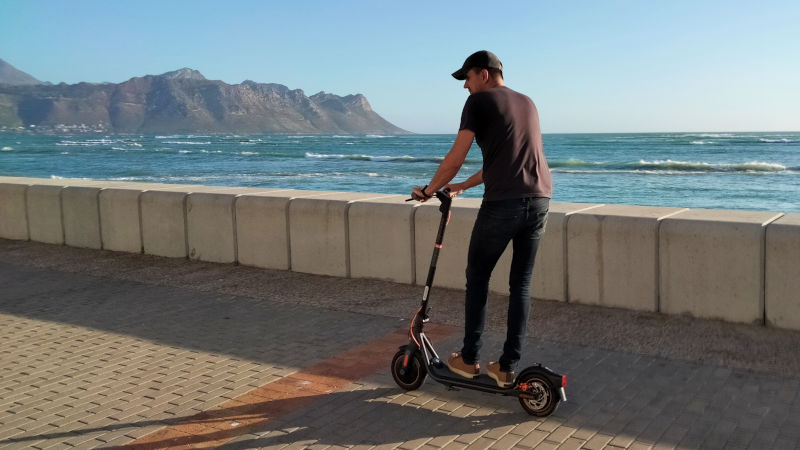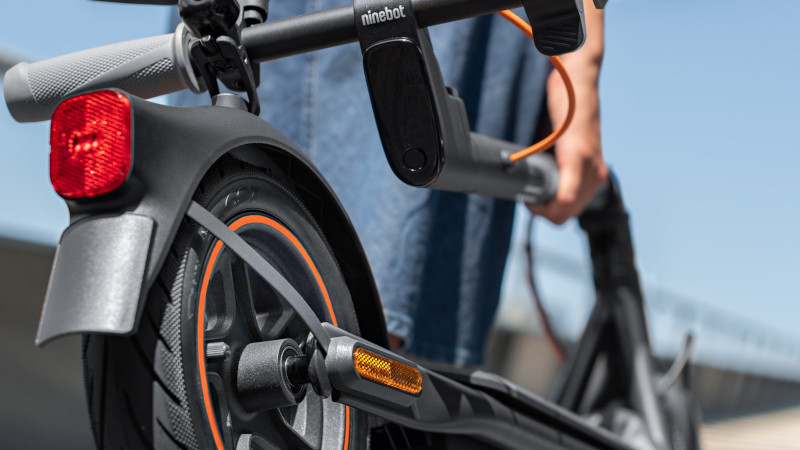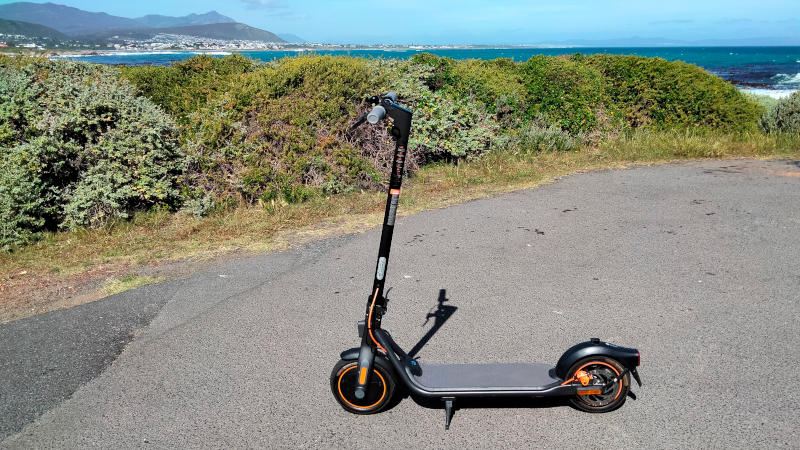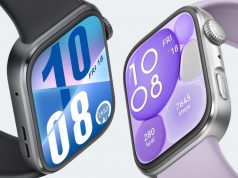Could an electric kick scooter be practical in a South African context, or are they just expensive toys? Michael MacIntyre tested the Segway-Ninebot F40E to help him answer the question.
There’s no doubt electric kick scooters offer barrels of fun to most people. But, at well over R10 000 for one of these scoots, I wanted to know if it could earn its keep by fulfilling additional duties. Like doing a bread-and-milk run at night or transporting me to the office, which is 5 km from home.
Key features of the Segway-Ninebot F40E electric kick scooter:
Top speed: 25 km/h
Max range per charge: 40 km
Battery charge time: Up to 6.5 hours
Price: R14 490
Who is it for?
This is what we wanted to discover. Electric kick scooters are not a familiar sight in South Africa, but there is interest in these products as a way of getting around town or commuting to work. But this form of mobility does sound more suited to Europe or Asia. Could it also work in Mzansi?
GO Electric, a local dealer in e-kicks, lent us the Segway-Ninebot F40E (R14 490), for testing purposes. Two lower-spec models, the F25E (R11 990) and F30E (R12 990), are also available.
What’s in the box?
The box contains the scooter, along with a charger similar in shape and size to that of a laptop. A few basic tools for assembly are included, as well as a booklet that explains how the scooter’s app works.

Setting up the Segway-Ninebot F40E
Initial set-up is quick. The only assembly required is connecting the handlebars to the scooter and inflating the self-sealing tyres. Registration of your new scooter happens via the downloadable Segway-Ninebot app.
You can charge the scooter’s battery from a standard wall socket, much like a smartphone. Charging takes up to 6.5 hours, from completely drained to fully charged.

Unplug-and-play
Press the power button for two seconds to switch on, kick up the side stand, and push the thumb throttle to make the Segway-Ninebot go. As a safety measure, a manual kick-push is required to get going, before the motor instantly takes over.
Power delivery is smooth, and the F40E quickly gets up to speed. (Suddenly, for some reason, I found myself longing to be a security guard in a mall, chasing down a shoplifter.) Balancing is easy – much easier than balancing on a skateboard. Acceleration is brisk, but certainly not scary.

Urban worrier
At first, negotiating pavements and sidewalks felt like quite an adventure. I managed to avoid holes in the sidewalk, preventing unwanted catapults. It’s a long way down if you fall, so be sure to wear a cycling or skateboarding helmet.
The steering is quick and responsive, and I quickly found that I can avoid obstacles easily. The steering felt a little twitchy at times, so it might take some time before a rider can manoeuvre confidently.
[mailchimp_list]
The handlebar hinges down to clip onto the rear mudguard, and the steering column becomes a carry handle. Though nimble in use, the Ninebot is quite bulky. This no child-powered kick-scooter. When trying to fit both the Segway-Ninebot and a slightly bigger NIU e-kick scooter into my Honda Civic’s boot, it felt like I was losing at Tetris.

What we like about the Segway-Ninebot F40E
Kick-scooters present a fresh take on getting from A to B. Still, only a small percentage of South Africans would be able to commute with a scoot like the Segway-Ninebot F40E, because it requires safe and smooth paths and surfaces. If it is compatible with your commute, there are plenty of benefits to using an e-kick. You wouldn’t have to shower or change shoes at the office (which cyclists usually must do), despair at another fuel-price increase, or suffer long queues at traffic lights. My wife loved the Ninebot too and remarked that she can ride it while wearing a dress, something she wouldn’t do on a bicycle.
The Segway-Ninebot feels well-made and sturdy, and the ergonomics are thoughtfully conceived. At 1.9m tall, I thought I would be too tall for the scooter but didn’t experience aches or pains, even after a 20 km ride, nor the next day. The F40E is user friendly and easy to ride.

Where Segway-Ninebot could improve the F40E
The F40E’s approach and departure angles are limiting at times. This caused scrapes to the front of its underbelly and risked damage to the rear mudguard. Care is advised when descending from or mounting kerbs.

Conclusion and score
If you live in a city that maintains its sidewalks (I’m lucky to live in Somerset West), and the office is no further than 10 or 15 kilometres from home, the F40E is awesome in its practicality and usefulness. However, if you need to hustle kids and dog food in your lunch hour, the Ninebot will be a fun weekend toy only.
The Segway-Ninebot F40E scores 4 out of 5.
4.0 out of 5.0 starsRelated product offers

Specifications
- Top speed: 25 km/h
- Max range per charge: 40 km
- Battery charge time: 6.5 hours
- App connectivity: Via Bluetooth
- Lights: 2.1-watt front LED, plus brake and rear lights
- Max climb gradient: 20 percent
- Brakes: Front electronic brake, rear disc brake
- Wheels: 10-inch tubeless pneumatic tyres with jelly layer
- Safety: Reflectors front, side, and rear
- Recommended age: 14+
- Max. driver weight: 120 kg (264 lbs)
- Net weight: 17.1 kg
- Battery: 367 Wh (10.2Ah)
- Brake Front: Electronic brake & rear disc brake
- Riding modes: Three riding modes (Eco, Standard, Sport) and 1 walk mode
- Reflectors: Yes (front, rear and side E-MARK reflectors)





























